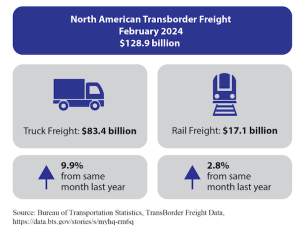Berkshire’s railroad revamps service with billions, fewer cars
By: Reuters | Mar 11 2015 at 04:57 PM | Intermodal
Stung by customer backlash over last winter’s patchy service, Berkshire Hathaway’s BNSF Railways invested billions in shoring up its operations.
But in addition to hiring more than 7,000 new workers and spending $5.5 billion on improvements to its 32,500-mile (52,300 kilometer) network, the railway also has done something unexpected: it pulled thousands of rail cars off its lines.
The strategy appears to have paid big dividends this winter, helping ease congestion on tracks and speed up traffic, according to a Reuters analysis of weekly data the industry supplies to the U.S. Department of Transportation.
BNSF rail cars that were stuck at terminals for an average of 35 hours last winter are now back on the tracks in less than a day. The trains are also moving 15 percent faster than they did last year, reducing critical travel times, data shows.
“BNSF disappointed many of its customers,” Berkshire Hathaway CEO Warren Buffett said in a letter to shareholders last month about last year’s performance of one of North America’s top railroads.
“However, our outsized expenditures are beginning to show results.”
The railway’s metrics, which have not been previously reported, have improved markedly this winter, reflecting less congestion, increased investments and weaker demand from the oil and agricultural industries. Since October, BNSF has cut its number of cars by 9 percent to just under 237,000, whereas the rest of the industry grew by 0.4 percent.
Anthony Hatch, owner of New York-based transportation consultancy ABH Consulting says all rail operators struggle to strike the balance between the number of cars on the tracks and freight volumes. BNSF is the only major U.S. rail operator, though, to cut the number of cars in the past two years.
More with Less
In its latest report, BNSF showed strong year-over-year increases in the number of carloads of grain and petroleum products hauled during the first two months of 2015 combined with double-digit declines in container and trailer volumes.
BNSF spokesman Mike Trevino said that improvements, such as building extra tracks and sidings, essentially allowed fewer cars to move the same amounts of freight.
“We did some things operationally that allowed us to take cars off the railroad while still being able to generate the same or better number of movements,” Trevino said.
Other major rail carriers also have spent billions on upgrades and bigger workforce, but none has reduced car counts or seen as dramatic improvements in travel speed and the time cars spent in terminals.
CSX, which last year carried about a quarter of BNSF’s crude load, reported relatively steady car dwell times. Canadian Pacific, which faced similar criticism as the much larger BNSF, saw small overall decreases in dwell times.
CSX spokeswoman Melanie Cost said the company has hired 1,900 frontline employees in 2014, bought new locomotives and upgraded lines where crude oil traffic has soared to ease capacity constraints and improve performance.
BNSF’s geographical focus on the nation’s Corn Belt states, along with North Dakota, a leading shale oil and grain producer, means it struggled more than its peers to keep up with demand generated by the oil boom and bumper crops.
The stress, aggravated by a series of paralyzing winter storms, led to nagging delays that plagued major shippers and triggered scrutiny from U.S. lawmakers and regulators.
One refiner, Philadelphia Energy Solutions, was hit so hard by the delays last year that it ordered a half-dozen extra tankers of crude before the start of this winter season.
This year, however, the extra reserve proved unnecessary, leaving the laden tankers idling offshore for months, according to a trader with knowledge of the situation. The company would not comment on its supplies.
Other big customers are also taking note of the improvement in areas served by BNSF, which pledged further $6 billion for capital maintenance in 2015 touting it the biggest amount ever invested in a single year by a North American rail company.
“Rail was a lot better this year. We didn’t see the delays,” said Mark Formo, president of the North Dakota Grain Growers Association. “In fact, we saw cars showing up for deliveries a day early.”
In a February survey by the Soy Transportation Coalition all respondents said cycle times - how long it takes a train to pick up a shipment, deliver it and return - have improved from last year.
To be sure, some customers primarily credit fewer weather-related disruptions and cooled demand for oil-by-rail and grain shipments for better service.
“To me it’s market driven,” said Brian Hammerbeck, president of Dakota Mill & Grain. “Prices are down, and you have farmers keeping more of it, so it’s a much different environment.”
ABH’s Hatch says, however, many factors were at play, including rail operators’ determined push.
“Weather helped, money helped, focus helped, time helped.” (Reuters)








